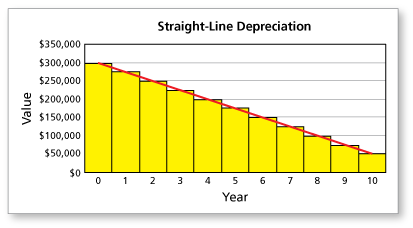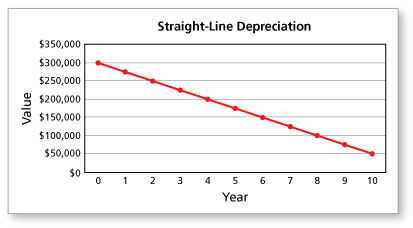-
An easy way to make a depreciation schedule is to enter the information into a spreadsheet.
When you do not have access to a spreadsheet, you can use a scientific calculator to find the annual depreciation by the straight-line method. Try using these steps.
- Subtract the salvage value from the purchase price.
- Divide by the years of useful life.
- Round to the nearest cent.
In Example 2, it was noted that in straight-line depreciation the same amount is expensed each year. Graphically, this creates a linear pattern, hence the name "straight-line depreciation." The figures below illustrate the linear pattern.


-
Have you ever wondered what life on the farm is like? Check out Window on the Prairie to get a bird's eye view of what it's like to live on a farm. You can even view pictures from the inside of a wheat combine and see what a farmer sees as he harvests wheat.
-
According to the depreciation schedule spreadsheet shown in Example 2, after five years, the combine was worth $175,000. If he sells it for $180,000, he should report the $5000 difference on his tax return. It will be taxed like regular income by the Internal Revenue Service. Taxing the difference on something sold for higher than its depreciated value is called depreciation recapture.
-
Comments (2)
These comments are not screened before publication. Constructive debate about the information on this page is welcome, but personal attacks are not. Please do not post comments that are commercial in nature or that violate copyright. Comments that we regard as obscene, defamatory, or intended to incite violence will be removed. If you find a comment offensive, you may flag it.
When posting a comment, you agree to our Terms of Use.Showing 2 commentsSubscribe by email Subscribe by RSSGuest 1 decade ago |Here is part of a report from ColoradoCorn.com. "During these economically stressful times, rising food prices can lead to questions about how much profit a farmer actually makes. With 98.5 percent of the population not working in agriculture, it becomes easy to make assumptions based upon only the prices on the shelves. But, in all actuality, farmers must spend a large percentage of the price they will get after harvest on the inputs necessary to grow the crops that provide food, feed and fuel. Not only does it costs a significant amount of money to farm, but growers must plant each spring without knowing what they will recoup in the fall."0 0Ron Larson (author)1 decade ago |Isn't it amazing that a grain harvester cost so much! From this example, you get some feeling for the costs involved in farming.0 0





